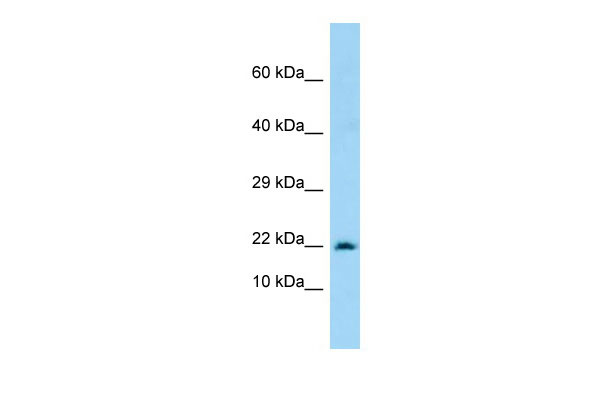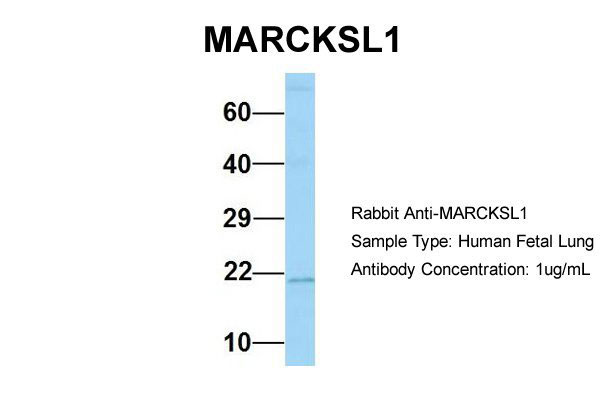MARCKSL1 antibody - C-terminal region
Rabbit Polyclonal Antibody
- SPECIFICATION
- CITATIONS
- PROTOCOLS
- BACKGROUND

Application
| WB |
|---|---|
| Primary Accession | P49006 |
| Other Accession | NM_023009, NP_075385 |
| Reactivity | Human, Mouse, Rat, Rabbit, Pig, Horse, Bovine, Dog |
| Predicted | Mouse, Horse, Dog |
| Host | Rabbit |
| Clonality | Polyclonal |
| Calculated MW | 19kDa |
| Gene ID | 65108 |
|---|---|
| Alias Symbol | F52, MACMARCKS, MLP, MLP1, MRP |
| Other Names | MARCKS-related protein, MARCKS-like protein 1, Macrophage myristoylated alanine-rich C kinase substrate, Mac-MARCKS, MacMARCKS, MARCKSL1, MLP, MRP |
| Format | Liquid. Purified antibody supplied in 1x PBS buffer with 0.09% (w/v) sodium azide and 2% sucrose. |
| Reconstitution & Storage | Add 50 ul of distilled water. Final anti-MARCKSL1 antibody concentration is 1 mg/ml in PBS buffer with 2% sucrose. For longer periods of storage, store at 20°C. Avoid repeat freeze-thaw cycles. |
| Precautions | MARCKSL1 antibody - C-terminal region is for research use only and not for use in diagnostic or therapeutic procedures. |
| Name | MARCKSL1 |
|---|---|
| Synonyms | MLP, MRP |
| Function | Controls cell movement by regulating actin cytoskeleton homeostasis and filopodium and lamellipodium formation (PubMed:22751924). When unphosphorylated, induces cell migration (By similarity). When phosphorylated by MAPK8, induces actin bundles formation and stabilization, thereby reducing actin plasticity, hence restricting cell movement, including neuronal migration (By similarity). May be involved in coupling the protein kinase C and calmodulin signal transduction systems (By similarity). |
| Cellular Location | Cytoplasm, cytoskeleton {ECO:0000250|UniProtKB:P28667}. Cell membrane; Lipid- anchor. Note=Associates with the membrane via the insertion of the N-terminal N-myristoyl chain and the partial insertion of the effector domain. Association of the effector domain with membranes may be regulated by Ca(2+)/calmodulin. Colocalizes with F-actin at the leading edge of migrating cells (By similarity). In prostate cancers, shows strong expression at apical and/or basal regions of the cell and also has weak cytoplasmic expression (PubMed:22751924). {ECO:0000250|UniProtKB:P28667, ECO:0000269|PubMed:22751924} |

Thousands of laboratories across the world have published research that depended on the performance of antibodies from Abcepta to advance their research. Check out links to articles that cite our products in major peer-reviewed journals, organized by research category.
info@abcepta.com, and receive a free "I Love Antibodies" mug.
Provided below are standard protocols that you may find useful for product applications.
References
Blockx H.,et al.Submitted (FEB-1993) to the EMBL/GenBank/DDBJ databases.
Bechtel S.,et al.BMC Genomics 8:399-399(2007).
Gregory S.G.,et al.Nature 441:315-321(2006).
Mural R.J.,et al.Submitted (SEP-2005) to the EMBL/GenBank/DDBJ databases.
Olsen J.V.,et al.Cell 127:635-648(2006).
If you have used an Abcepta product and would like to share how it has performed, please click on the "Submit Review" button and provide the requested information. Our staff will examine and post your review and contact you if needed.
If you have any additional inquiries please email technical services at tech@abcepta.com.













 Foundational characteristics of cancer include proliferation, angiogenesis, migration, evasion of apoptosis, and cellular immortality. Find key markers for these cellular processes and antibodies to detect them.
Foundational characteristics of cancer include proliferation, angiogenesis, migration, evasion of apoptosis, and cellular immortality. Find key markers for these cellular processes and antibodies to detect them. The SUMOplot™ Analysis Program predicts and scores sumoylation sites in your protein. SUMOylation is a post-translational modification involved in various cellular processes, such as nuclear-cytosolic transport, transcriptional regulation, apoptosis, protein stability, response to stress, and progression through the cell cycle.
The SUMOplot™ Analysis Program predicts and scores sumoylation sites in your protein. SUMOylation is a post-translational modification involved in various cellular processes, such as nuclear-cytosolic transport, transcriptional regulation, apoptosis, protein stability, response to stress, and progression through the cell cycle. The Autophagy Receptor Motif Plotter predicts and scores autophagy receptor binding sites in your protein. Identifying proteins connected to this pathway is critical to understanding the role of autophagy in physiological as well as pathological processes such as development, differentiation, neurodegenerative diseases, stress, infection, and cancer.
The Autophagy Receptor Motif Plotter predicts and scores autophagy receptor binding sites in your protein. Identifying proteins connected to this pathway is critical to understanding the role of autophagy in physiological as well as pathological processes such as development, differentiation, neurodegenerative diseases, stress, infection, and cancer.



